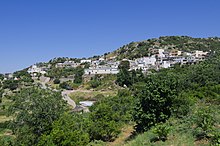
Axos (in Greek, Αξός) is a local community and a village in the municipality of Milopotamos, in Crete. In 2011, the community had a population of 424 and the village had 385 residents. It contains remains of the ancient city of Oaxo or Axo (in Greek, Ὄαξος, Ϝάξος or Ἄξος).
History and archaeology
The city's name is documented on Mycenaean tablets in Linear B as e-ko-so. An initial settlement southeast of the modern village of Axos was built on a hill at an elevation of 600 meters, during the Late Minoan III C period. However, few remains from this early period have been preserved, although some pottery fragments indicate that there was a presence at the site during the Dark Ages. It was subsequently inhabited from the Geometric period until the Byzantine period.
The first excavations were conducted in 1899 by the Italian Archaeological School. Findings from the excavations included pottery, stone vessels, inscriptions, and many figurines of naked women.
On the hill above the village of Axos is the acropolis, where remnants of the surrounding wall can be seen, as well as the Andrión, a Greek temple dedicated to the goddess Aphrodite Astarte, and the prytaneum of the polis. Ancient tombs and inscriptions on large stones, possibly laws, were also identified.
In ancient literary sources, Axos is mentioned by Herodotus as an important city ruled by Etearchus, father of Phronima, who had a son named Bato, who according to tradition played an important role in the founding of Cyrene.
It is also mentioned in a list of Cretan cities cited in a decree from Knossos dated around 259/233 BCE. and in a list of Cretan cities that signed an alliance with Eumenes II of Pergamum in 183 BCE.
Coins minted by Axos dating from approximately 380 BCE have been preserved.
Throughout history, the city has been mentioned by classical authors: Herodotus, Virgil, Cicero, Strabo, Stephen of Byzantium and Cristoforo Buondelmonti.
In the Argonautica by Apollonius of Rhodes, Axos is identified as the place where the nymph Anchiale gave birth to the Dactyls of Ida, in a cave on Mount Dicte.
During the Roman and Byzantine periods, the city prospered, becoming an important episcopal see with many churches. It is also mentioned in the list of 22 Cretan cities by the Byzantine geographer of the 1 Hierocles.
References
- "2011 Census Detail (in Greek)". Archived from the original on 16 October 2015. Retrieved 23 July 2024.
- Francisco Aura Jorro, The Geography of Mycenaean States. Methodologies and Results, p.679, note 19, in Festschrift in Honor of Professor Antonio Gil Olcina, University of Alicante (2016). ISBN 978-84-16724-09-3.
- Zöller, Sebastian (2005). "The Society of the Early "Dark Centuries" in Crete" (PDF) (Doctoral Thesis) (in German). Heidelberg University. p. 101. Retrieved 23 July 2024.
- ^ "Archived copy". Crete-kreta.com. Archived from the original on 11 January 2013. Retrieved 23 July 2024.
{{cite web}}: CS1 maint: archived copy as title (link) - "Places to visit Crete". Enagron.gr. Retrieved 23 July 2024.
- Herodotus IV,154.
- SEG 29, 1135
- IC IV,179.
- Mogens Herman Hansen and Thomas Heine Nielsen (2004). "Crete". An Inventory of Archaic and Classical Poleis. New York: Oxford University Press. pp. 1153-1154. ISBN 0-19-814099-1. Retrieved 23 July 2024.
- Apollonius of Rhodes II,1120.
- Hierocles, Synecdemus.